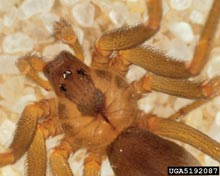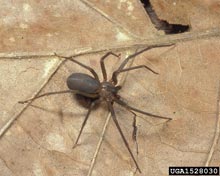
Florida Division of Plant Industry Archive, Florida Department of Agriculture & Consumer Services

Sturgis McKeever, Georgia Southern University
Brown Recluse Spiders
General Description
True to its name, the brown recluse is both brown and reclusive. The body of the adult is light brown, except for
a darker, violin-shaped marking on the back, immediately behind its eyes. This mark helps identify the spider,
though it develops as the spider does and is not present in younger brown recluses. A more important identifier is
the number and arrangement of the eyes. Unlike most spiders that have eight eyes, brown recluse spiders have
six eyes arranged in three pairs. Note also that the legs of a brown recluse are not spiny or banded like those of
many other spiders it is often confused with. Brown recluses are most active at night. During the day they rest in
hidden locations within the structures they infest. While females build flat, sheet-like webs, or “retreats,” and are
more sedentary, the brown recluse should be thought of as a hunting spider because males, in particular, roam
in search of prey.
General Control
Successful brown recluse control requires an integrated management plan that utilizes several control methods.
Plans employing only one means of control, such as spraying baseboards, will fail. Removing clutter, using sticky
traps, and close inspection of materials coming in and out of the structure will help control the brown recluse.
Pesticides are often a necessary part of brown recluse management. Applications should be targeted on cracks
and voids where the brown recluse are known or suspected to be. A larger volume of pesticides may be called for
in infested crawlspaces and attics, or around foundation perimeters where brown recluse are found living around
a structure’s exterior. Encapsulated formulations of residual pesticides are effective. Dust formulations (pesticides
in powdered form) also are good for treating spaces such as wall voids.









